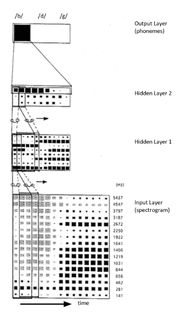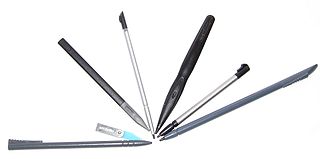
Optical character recognition or optical character reader (OCR) is the electronic or mechanical conversion of images of typed, handwritten or printed text into machine-encoded text, whether from a scanned document, a photo of a document, a scene-photo or from subtitle text superimposed on an image.
Segment or segmentation may refer to:

Handwriting recognition (HWR), also known as Handwritten Text Recognition (HTR), is the ability of a computer to receive and interpret intelligible handwritten input from sources such as paper documents, photographs, touch-screens and other devices. The image of the written text may be sensed "off line" from a piece of paper by optical scanning or intelligent word recognition. Alternatively, the movements of the pen tip may be sensed "on line", for example by a pen-based computer screen surface, a generally easier task as there are more clues available. A handwriting recognition system handles formatting, performs correct segmentation into characters, and finds the most plausible words.

In digital image processing and computer vision, image segmentation is the process of partitioning a digital image into multiple segments. The goal of segmentation is to simplify and/or change the representation of an image into something that is more meaningful and easier to analyze. Image segmentation is typically used to locate objects and boundaries in images. More precisely, image segmentation is the process of assigning a label to every pixel in an image such that pixels with the same label share certain characteristics.

Cursive is any style of penmanship in which some characters are written joined together in a flowing manner, generally for the purpose of making writing faster, in contrast to block letters. Cursive handwriting is very functional, and is intended to be used in everyday writing. In addition, it is also used in art and calligraphy hand-lettering. Formal cursive is generally joined, but casual cursive is a combination of joins and pen lifts. The writing style can be further divided as "looped", "italic" or "connected".
Document processing is a field of research and a set of production processes aimed at making an analog document digital. Document processing does not simply aim to photograph or scan a document to obtain a digital image, but also to make it digitally intelligible. This includes extracting the structure of the document or the layout and then the content, which can take the form of text or images. The process can involve traditional computer vision algorithms, convolutional neural networks or manual labor. The problems addressed are related to semantic segmentation, object detection, optical character recognition (OCR), handwritten text recognition (HTR) and, more broadly, transcription, whether automatic or not. The term can also include the phase of digitizing the document using a scanner and the phase of interpreting the document, for example using natural language processing (NLP) or image classification technologies. It is applied in many industrial and scientific fields for the optimization of administrative processes, mail processing and the digitization of analog archives and historical documents.
The following is an alphabetical index of articles related to graphonomics:
The difference between on-line handwriting recognition and off-line handwriting recognition is that temporal information is present in the on-line pen-tip trajectory Xt, Yt. This means that the order of movements is contained with an on-line recording of handwriting on a Graphics Tablet. In handwriting recognition, the temporal information usually helps to disambiguate between characters that are touching in the image, but which are disparate in the temporal order.
In handwriting research, the concept of stroke is used in various ways. In engineering and computer science, there is a tendency to use the term stroke for a single connected component of ink or a complete pen-down trace. Thus, such stroke may be a complete character or a part of a character. However, in this definition, a complete word written as connected cursive script should also be called a stroke. This is in conflict with the suggested unitary nature of stroke as a relatively simple shape.

A digital pen is an input device which captures the handwriting or brush strokes of a user and converts handwritten analog information created using "pen and paper" into digital data, enabling the data to be utilized in various applications. This type of pen is usually used in conjunction with a digital notebook, although the data can also be used for different applications or simply as a graphic.
Speech segmentation is the process of identifying the boundaries between words, syllables, or phonemes in spoken natural languages. The term applies both to the mental processes used by humans, and to artificial processes of natural language processing.
Text segmentation is the process of dividing written text into meaningful units, such as words, sentences, or topics. The term applies both to mental processes used by humans when reading text, and to artificial processes implemented in computers, which are the subject of natural language processing. The problem is non-trivial, because while some written languages have explicit word boundary markers, such as the word spaces of written English and the distinctive initial, medial and final letter shapes of Arabic, such signals are sometimes ambiguous and not present in all written languages.

Pen computing refers to any computer user-interface using a pen or stylus and tablet, over input devices such as a keyboard or a mouse.
A text entry interface or text entry device is an interface that is used to enter text information an electronic device. A commonly used device is a mechanical computer keyboard. Most laptop computers have an integrated mechanical keyboard, and desktop computers are usually operated primarily using a keyboard and mouse. Devices such as smartphones and tablets mean that interfaces such as virtual keyboards and voice recognition are becoming more popular as text entry systems.

Time delay neural network (TDNN) is a multilayer artificial neural network architecture whose purpose is to 1) classify patterns with shift-invariance, and 2) model context at each layer of the network.

In computing, a stylus is a small pen-shaped instrument whose tip position on a computer monitor can be detected. It is used to draw, or make selections by tapping. While devices with touchscreens such as newer computers, mobile devices, game consoles, and graphics tablets can usually be operated with a fingertip, a stylus provides more accurate and controllable input. The stylus has the same function as a mouse or touchpad as a pointing device; its use is commonly called pen computing.
This is a software system for forensic comparison of handwriting. It was developed at CEDAR, the Center of Excellence for Document Analysis and Recognition at the University at Buffalo. CEDAR-FOX has capabilities for interaction with the questioned document examiner to go through processing steps such as extracting regions of interest from a scanned document, determining lines and words of text, recognize textual elements. The final goal is to compare two samples of writing to determine the log-likelihood ratio under the prosecution and defense hypotheses. It can also be used to compare signature samples. The software, which is protected by a United States Patent can be licensed from Cedartech, Inc.
Time-series segmentation is a method of time-series analysis in which an input time-series is divided into a sequence of discrete segments in order to reveal the underlying properties of its source. A typical application of time-series segmentation is in speaker diarization, in which an audio signal is partitioned into several pieces according to who is speaking at what times. Algorithms based on change-point detection include sliding windows, bottom-up, and top-down methods. Probabilistic methods based on hidden Markov models have also proved useful in solving this problem.
Sayre’s Paradox is a dilemma encountered in the design of automated handwriting recognition systems. A standard statement of the paradox is that a cursively written word cannot be recognized without being segmented and cannot be segmented without being recognized. The paradox was first articulated in a 1973 publication by Kenneth M. Sayre, after whom it was named.
In computer vision, rigid motion segmentation is the process of separating regions, features, or trajectories from a video sequence into coherent subsets of space and time. These subsets correspond to independent rigidly moving objects in the scene. The goal of this segmentation is to differentiate and extract the meaningful rigid motion from the background and analyze it. Image segmentation techniques labels the pixels to be a part of pixels with certain characteristics at a particular time. Here, the pixels are segmented depending on its relative movement over a period of time i.e. the time of the video sequence.







